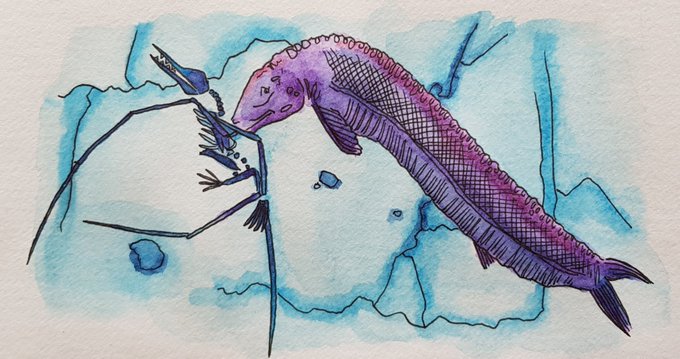FOSSILFRIDAYのTwitterイラスト検索結果。 1,209 件中 38ページ目
#FossilFriday #Radiolaria and I guess Exhibit C would be this cutie I described a few years ago: Enneaphormis tippula Renaudie & Lazarus 2016 (here the holotype from the late Miocene of ODP site 746A).
As I recover from my wisdom tooth extraction on #FossilFriday, I was reminded of this amazing fossil shark from Peru in the collections of @FloridaMuseum. I don't know why.
You can read more about the discovery here: https://t.co/sVIZ6qvJ8i
Read the latest edition of Mesozoic Monthly to learn all about the dinosaur known as the “giant thunderclap at dawn.” #FossilFriday https://t.co/efm9muZSiQ
In Anth 211 this week, students will try to virtually reconstruct the Nariokotome Homo erectus cranium, based on the individual bones they digitized last week #FossilFriday
Our #PalaeoPoemsPrompt for this #FossilFriday is truly transformative! We'd like you to write a short poem about the sea to land evolutionary transition. Our featured pictures were taken by @DanaKorneisel and show a robotic skeleton model and accompanying artwork of Acanthostega!
As voted earlier this morning, here is my sketch/speedpaint today: the large, big headed stem-tetrapod Crassigyrinus scoticus. My entry for today’s #FossilFriday There are two Crassigyrinus here #paleoart #sciart
The primates in PALEOCENE aren't based on a known fossil species, but are hypothetical ancestors of tarsiers and monkeys. They'd be similar to this Archicebus (illustration by Mat Severson, CC-BY-SA 4.0 license). #FossilFriday
The second article all about the #evolution of #flight. This time taking a look at the first #vertebrates to take to the skies. #UnlockingThePast this #FossilFriday with the #Pterosaurs: https://t.co/WZZAkPw9Ft
#Eudimorphodon #palaeoart by @TheWoodParable
E is for Euoplocephalus. It's name literally means 'well-armoured head'. And it was. This anyleosaurid giant, was tail whipping and head butting in Canada around 80 million years ago. #FossilFriday
(Photo Victoria Arbour & Philip Currie; Art John Sibbick)
Found these little #BurgessShale creatures at the Oxford University Museum of Natural History @morethanadodo - Wiwaxia (a bit squished after the transatlantic flight), Trilobite, Opabinia, and Marrella #FossilFriday
#fossilfriday A very hungry #dinosaur. Built by George H. Messmore and Joseph Damon, this beast roamed across the #roxytheater Fortunately, it was an herbivore so no harm done to the young woman.
The type specimen of the Columbian mammoth was found in south Georgia (USA), in the mid 1800s. This one, mounted @MSUMuseum, was found in Kansas back in 1971! #FossilFriday
For our #Wunderkammer exhibition @hastings_museum I chose these #dinosaur stomach stones & #coprolites collected by Edward John Baily 1859-1939. We didn't know we had the fossil poos before I opened the box 3 months ago. #FossilFriday @MrIchthyosaurus @Dean_R_Lomax #Cretaceous
Progress on the #Iguanodon tonight. Looking good. #sciart #paleoart #fossilfriday #dinosaurs
For #FossilFriday I'll share one of my favourite fossils:
Rhamphorhynchus flies over water.
Snap! Catches a fish.
Then (there's always a bigger fish) SNAP! get's caught by a Aspidorhynchus leaping out the water! But it's too chewy, entangles with the teeth! Oh no, all die!
@eawilloughby 2010 brought news of the exciting discovery of Concavenator, a Spanish allosauroid. It's excellent, but the claim that it might have had forelimb feathers was questioned in this #TetZoo article: https://t.co/Oo1QxLUegZ #dinosaurs #FossilFriday
More for #FossilFriday
A fish corpolite that found in thailand. It was dated to be around the triassic period.
Interestingly that thai locals who found this think that it's a "stone pupa" a magical rock that can heal everything.
For #FossilFriday a species I am working with right now! Ampelomeryx is a kind of "#punk #giraffe" with several ossicones that lived in Europe 18Mya. It possesses #sabertooth ... YES a punk giraffe with sabertooth !!!
#weloveruminants #fossils #mammals #paleontology
#3January #January3 #3Gennaio 2020
Carcharocles angustidens🦈
"There were no human beings to devour when this mighty relative of the existing white shark swam the seas"
D. Bashford - The Department of Fishes, American Museum
Natural History V. 23 (1923)
#fossils #fossilfriday
First #fossilfriday of the year. Not a sketch today, but a photogrammetry of the trilobite Crozonaspis struvei I did for my final essay of Invertebrates Palaeontological. Not the best specimen, but you can see most it's cephalon features, including the cool tiny eye lenses!

















































